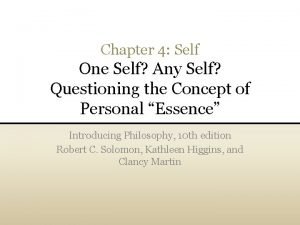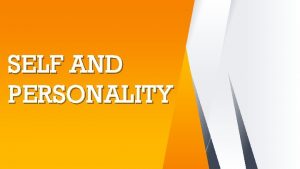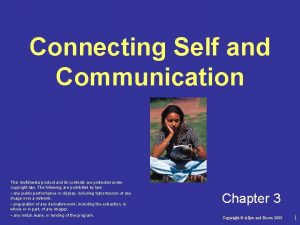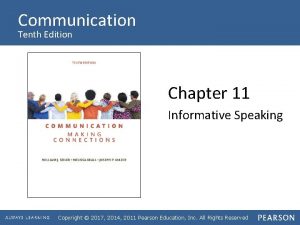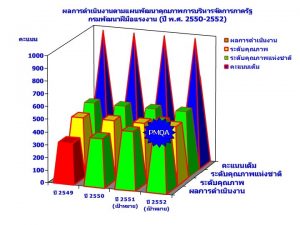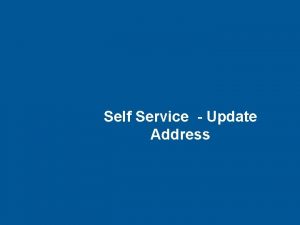Communication Tenth Edition Chapter 3 Connecting Self and























- Slides: 23

Communication Tenth Edition Chapter 3 Connecting Self and Communication Copyright © 2017, 2014, 2011 Pearson Education, Inc. All Rights Reserved

Learning Objectives (1 of 2) 3. 1 Differentiate among self-concept, selfimage, and self-esteem. 3. 2 Identify social media factors that influence self-concept. 3. 3 Characterize the role of culture in determining self-concept. 3. 4 Characterize the role of gender in determining self-concept. Copyright © 2017, 2014, 2011 Pearson Education, Inc. All Rights Reserved

Learning Objectives (2 of 2) 3. 5 Explain the roles of self-fulfilling prophecy and impression management as they relate to self-concept. 3. 6 Identify six ways to improve self-concept. Copyright © 2017, 2014, 2011 Pearson Education, Inc. All Rights Reserved

Understanding Self-Concept (1 of 4) Learning Objective 3. 1: Differentiate among self-concept, self-image, and self-esteem. Copyright © 2017, 2014, 2011 Pearson Education, Inc. All Rights Reserved

Understanding Self-Concept (2 of 4) • Our self-concept is our perceived self. • It consists of two components: – Self-image, a person’s mental picture of him- or herself – Self-esteem, a person’s feelings and attitudes toward him- or herself • Self-concept and perception are closely related. Copyright © 2017, 2014, 2011 Pearson Education, Inc. All Rights Reserved

Figure 3. 1: The Self-Concept Copyright © 2017, 2014, 2011 Pearson Education, Inc. All Rights Reserved

Understanding Self-Concept (3 of 4) • Development of Self-Concept – Values are a person’s perceived self. – Attitudes are evaluative feelings. – Beliefs are convictions or confidence in the truth of something that is not based on absolute proof. Copyright © 2017, 2014, 2011 Pearson Education, Inc. All Rights Reserved

Understanding Self-Concept (4 of 4) • Communication and Self-Concept – Communication affects our self-concept. – Our perceptions of how others respond to us affect our self-concept. – Self-concept affects how we behave. – According to social psychologist John W. Kinch, our behavior is directly related to how others react to our behavior. – The personal-social identity continuum identifies the two ways the self can be categorized: at a personal level and at a social identity level. Copyright © 2017, 2014, 2011 Pearson Education, Inc. All Rights Reserved

Figure 3. 2: Kinch’s Model of the Connection between Self-Concept and Communication Copyright © 2017, 2014, 2011 Pearson Education, Inc. All Rights Reserved

Social Media and Self-Concept (1 of 5) Learning Objective 3. 2: Identify social media factors that influence self-concept. Copyright © 2017, 2014, 2011 Pearson Education, Inc. All Rights Reserved

Social Media and Self-Concept (2 of 5) • Our attitude toward online communication also influences our self-concept. • This orientation toward social media is called online communication attitude. Researchers have identified five attitudes that shape how we approach communication through social media: – Online self-disclosure – Online social connection – Convenience – Online Communication Apprehension – Miscommunication Copyright © 2017, 2014, 2011 Pearson Education, Inc. All Rights Reserved

Social Media and Self-Concept (3 of 5) • Online Self-Disclosure – Online self-disclosure is the degree to which an individual self-regulates what he or she reveals about him- or herself using social media. • Online Social Connection – Online social connection is the belief that online communication enables social contact. Copyright © 2017, 2014, 2011 Pearson Education, Inc. All Rights Reserved

Social Media and Self-Concept (4 of 5) • Convenience – Convenience is the ease with which people connect with others through social media. • Online Apprehension – Online communication apprehension is anxiety and nervousness associated with communicating through social media. Copyright © 2017, 2014, 2011 Pearson Education, Inc. All Rights Reserved

Social Media and Self-Concept (5 of 5) • Miscommunication – Miscommunication is the understanding that social media may naturally inhibit the clarity of communication. Copyright © 2017, 2014, 2011 Pearson Education, Inc. All Rights Reserved

Culture and Self-Concept (1 of 2) Learning Objective 3. 3: Characterize the role of culture in determining self-concept. Copyright © 2017, 2014, 2011 Pearson Education, Inc. All Rights Reserved

Culture and Self-Concept (2 of 2) • Self-concept varies from one culture to another. • It is determined by a combination of cultural norms and behaviors. – Individualistic orientation stresses self or personal goals. – Collectivistic orientation seeks the well-being of the group. Copyright © 2017, 2014, 2011 Pearson Education, Inc. All Rights Reserved

Gender and Self-Concept (1 of 3) Learning Objective 3. 4: Characterize the role of gender in determining self-concept. Copyright © 2017, 2014, 2011 Pearson Education, Inc. All Rights Reserved

Gender and Self-Concept (2 of 3) • Gender is a crucial element in our personal and social identity. • Sex and Gender – Terms are often used interchangeably. – Gender refers to socially constructed behaviors that are learned. – Sex is defined in biological terms. Copyright © 2017, 2014, 2011 Pearson Education, Inc. All Rights Reserved

Gender and Self-Concept (3 of 3) • Gender Stereotypes – Stereotypes and narrowly defined role expectations are still accepted by many in Western culture and even more so in certain other cultures. • Gender Expectations – Sex differences in communication result from gender expectations. – Despite some strides toward equality of the sexes, many cultures still have a cultural bias toward masculinity. Copyright © 2017, 2014, 2011 Pearson Education, Inc. All Rights Reserved

Self-Fulfilling Prophecy and Impression Management (1 of 2) Learning Objective 3. 5: Explain the roles of self-fulfilling prophecy and impression management as they relate to self-concept. Copyright © 2017, 2014, 2011 Pearson Education, Inc. All Rights Reserved

Self-Fulfilling Prophecy and Impression Management (2 of 2) • Self-Fulfilling Prophecy – A self-fulfilling prophecy is the expectations we have of ourselves or that others have of us that help to create conditions that lead us to act predictably. • Impression Management – Impression management involves creating a positive image of oneself to influence others’ perception. – This process involves facework, the way we maintain our presenting image. Copyright © 2017, 2014, 2011 Pearson Education, Inc. All Rights Reserved

Enhancing Self-Concept (1 of 2) Learning Objective 3. 6: Identify six ways to improve self-concept. Copyright © 2017, 2014, 2011 Pearson Education, Inc. All Rights Reserved

Enhancing Self-Concept (2 of 2) • There are six ways you can improve self-concept: – Decide what you would like to change or improve about yourself. – Describe why you feel the way you do about yourself. – Make a commitment to improve or change. – Set reasonable goals for yourself. – Decide on the specific actions you are going to take. – Associate with positive people whenever possible. Copyright © 2017, 2014, 2011 Pearson Education, Inc. All Rights Reserved
 Campbell biology tenth edition
Campbell biology tenth edition Campbell biology tenth edition
Campbell biology tenth edition Campbell biology tenth edition
Campbell biology tenth edition Elementary statistics tenth edition
Elementary statistics tenth edition Digital fundamentals by floyd 10th edition
Digital fundamentals by floyd 10th edition Corporate finance tenth edition
Corporate finance tenth edition Psychology tenth edition david g myers
Psychology tenth edition david g myers Introduction to genetic analysis tenth edition
Introduction to genetic analysis tenth edition Corporate finance tenth edition
Corporate finance tenth edition Corporate finance tenth edition
Corporate finance tenth edition Corporate finance tenth edition
Corporate finance tenth edition Corporate finance tenth edition
Corporate finance tenth edition Campbell biology tenth edition
Campbell biology tenth edition The graph shows data from the light colored soil
The graph shows data from the light colored soil Cloroplastos
Cloroplastos Biology tenth edition
Biology tenth edition Real self vs ideal self drawing
Real self vs ideal self drawing Tenth chapter wired
Tenth chapter wired Tenth may dawned bright and clear
Tenth may dawned bright and clear Understanding human communication 14th edition chapter 1
Understanding human communication 14th edition chapter 1 Using mis 10th edition
Using mis 10th edition Using mis 10th edition
Using mis 10th edition The tenth man graham greene summary
The tenth man graham greene summary Ten thousandth
Ten thousandth

























